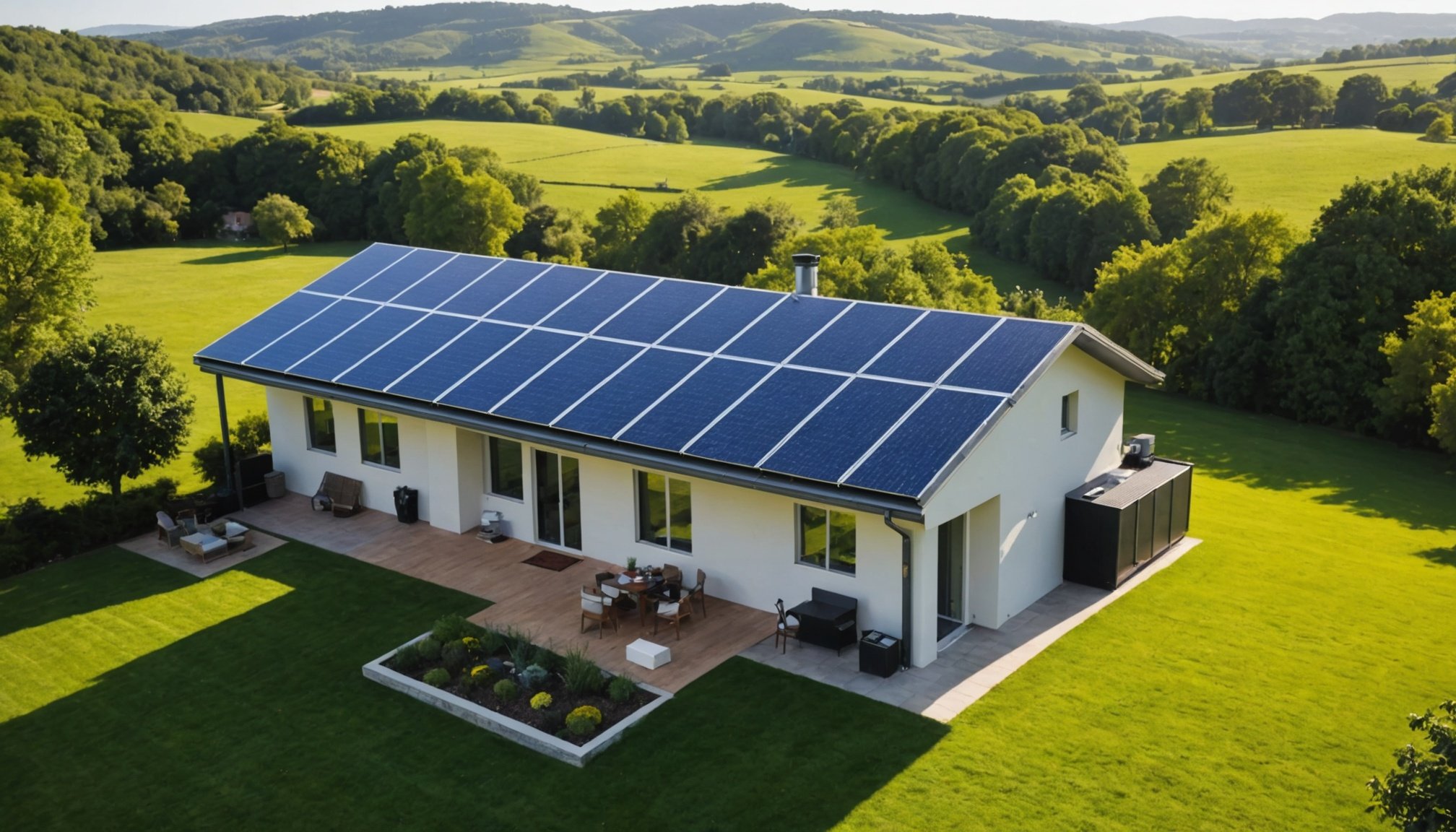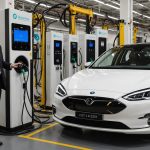Recent Advancements in Solar Energy Technologies
The solar energy sector has seen significant progress with the advent of new solar panel technologies, enhancing efficiency levels dramatically. Solar panels are becoming more efficient, the latest models boasting increased energy conversion rates by using innovative materials. For instance, perovskite-based solar cells have emerged as a promising alternative to traditional silicon, improving photovoltaic systems considerably.
Breakthroughs in photovoltaic materials have included multi-junction and thin-film technologies. Multi-junction cells stack different semiconductor materials to harness a broader spectrum of sunlight, leading to dramatic efficiency gains. Thin-film solar panels, lightweight and flexible, enable integration into various applications, showcasing versatility in design.
Also read : Unlocking the Power of AI: How Predictive Maintenance is Transforming the UK Energy Sector
These solar innovations are particularly beneficial when integrated into residential homes. Homeowners can now more easily incorporate photovoltaic systems into their daily energy consumption patterns. The environmental and economic benefits are substantial, as these systems reduce reliance on fossil fuels and decrease electricity bills. Enhancements in solar technology have also made installation simpler and more cost-effective, encouraging adoption across different demographics.
These advancements continue to push the boundaries of what’s possible with solar panels, signifying a brighter, more sustainable future. As these technologies evolve, their potential to reshape energy consumption patterns globally remains immensely promising.
Have you seen this : Enhancing Weather Forecasting in the UK: The Role of Deep Learning in Accurate Predictions
Wind Energy Solutions for Homeowners
Tapping into the power of residential wind turbines is becoming an increasingly viable option for homeowners. For those looking for a way to harness renewable energy, these small-scale wind energy solutions offer a promising alternative. Unlike traditional energy sources, wind innovations are now more adaptable and easier to install in residential settings.
An intriguing aspect of residential wind turbines is the cost comparison to solar energy. While both serve as renewable options, the initial investment for wind turbines can be steeper than solar panels. However, over time, maintenance and operational costs often align or even favour wind turbines, especially in regions with consistent wind patterns. Choosing between these options depends on specific environmental conditions and budgetary constraints.
Case studies highlight the practicality of adopting small-scale wind turbines at home. In coastal areas or open rural spaces, homeowners have successfully reduced their dependence on the grid. For example, a family in Cornwall installed a 5kW turbine, generating over 10,000 kWh annually, significantly reducing their electricity bills and promoting sustainability.
With these examples, it becomes evident: embracing residential wind turbines can be a transformative step towards energy independence, offering homeowners not just financial benefits, but also contributing to a greener planet.
Energy Storage Systems and Their Importance
In the evolving landscape of renewable energy, battery storage systems play a pivotal role. These systems store excess energy produced during peak times and release it when production dips, ensuring a consistent power supply. Home energy management utilises these systems to optimise energy usage, reducing homeowners’ reliance on the grid during high-demand periods. Effective integration of battery storage is key in enhancing the efficiency of renewable energy installations like solar and wind.
Modern renewable energy storage solutions come in various forms, each with unique functionalities. Lithium-ion batteries, for instance, are renowned for their high energy density and decreasing costs, making them a popular choice for both residential and commercial applications. Pumped hydroelectric and compressed air energy storage are alternatives, although they require larger installations.
Emerging trends in home battery systems reflect a growing market impact as consumers seek energy independence and cost savings. More sophisticated home energy management platforms now allow users to monitor and control their energy consumption remotely, facilitating a more environmentally-friendly lifestyle. With technological advancements, these systems are becoming more efficient and affordable, paving the way for broader adoption and integration into smart homes of the future.
Smart Home Integrations with Renewable Energy
In the realm of smart home technology, energy efficiency remains paramount. Energy management systems play a crucial role in optimising how energy is consumed. These systems intelligently manage energy resources, ensuring optimal usage and reducing waste. With them, homeowners can automate various devices to operate during off-peak hours, thereby cutting costs and utilising power more effectively.
The incorporation of IoT in renewables furthers this efficiency. IoT devices interact in real time with renewable energy sources, such as solar panels, to monitor and adjust power usage based on live data. This seamless communication ensures that appliances only draw energy when it is abundantly available, like during sunny hours for solar-powered homes, enhancing sustainability.
Several smart homes have successfully integrated these technologies with renewable energy systems. For instance, some homes utilise smart thermostats and lighting systems that adjust according to the availability of solar energy, maximising their reliance on renewable sources. Additionally, home batteries, like Tesla’s Powerwall, store excess solar energy harvested during the day for use during the night, synchronised with energy management systems for peak efficiency.
These integrations illustrate the potential of smart home technology to create eco-friendly living spaces by harmonising advanced technology with sustainable energy sources.
Case Studies and Real-World Applications
Exploring renewable energy case studies unveils numerous success stories of homeowners who have adopted renewable energy systems. These stories illustrate not only environmental consciousness but also substantial economic benefits. For instance, in regions like California, residential installations of solar panels have enabled homeowners to significantly reduce their energy bills while contributing to a substantial decline in carbon emissions.
Differing climates and socio-economic scenarios worldwide present a unique backdrop for renewable solutions. Areas with frequent sunshine, like Australia, exhibit increased adoption of solar energy, while countries with stronger wind patterns, such as Denmark, leverage wind turbines effectively. Each region’s outcome showcases varied strategies tailored to local resources, underscoring that adaptability is key.
These success stories provide valuable lessons for future adopters. In many cases, initial investment costs can be offset by government incentives or reduced utility bills. Additionally, awareness and community support have proven crucial in overcoming obstacles such as technological know-how and financial constraints.
Ultimately, examining these real-world applications highlights the feasibility and potential of home renewable energy systems. Emphasising community learning from practical experiences, new adopters are urged to explore tailored solutions matched to their environment, ensuring sustainability and long-term savings.
Expert Opinions on Future Innovations
Understanding the future of renewable energy requires delving into insights from energy experts who are shaping tomorrow’s innovations. These industry leaders predict a significant shift towards renewable energy in households, propelled by technological advancements and consumer demand for sustainable solutions.
Industry trends suggest we will see more efficient solar panels and home batteries, enabling homeowners to harness and store energy more effectively. Furthermore, experts anticipate smart grid technology will become more prevalent, allowing for better management and distribution of energy.
Adoption rates of renewable energy solutions are expected to increase as technology costs decrease and awareness grows among consumers. These advancements are set to make renewable energy more accessible and practical for everyday use.
However, potential challenges remain for homeowners looking to transition to renewable energy. These challenges include initial setup costs, integration with existing systems, and regulatory hurdles that can vary by region. Energy experts emphasize the importance of government incentives and support to overcome these barriers, hinting that collaboration between technology developers and policymakers will be critical for future success.
By addressing these challenges, the industry aims not only to enhance technology adoption but also to ensure a sustainable and efficient energy future for all homeowners.
Resources for Further Exploration
For homeowners interested in renewable energy resources, diving into educational materials and research articles can provide valuable insight and guidance. Understanding the latest advancements is crucial for making informed decisions about renewable energy conversions at home.
Start by exploring reputable sources that focus on the development of renewable energy technologies. Websites like the International Energy Agency and the U.S. Department of Energy offer a wealth of up-to-date information on advancements in solar, wind, and other green technologies. These sources provide industry insights that can help you stay abreast of emerging trends and best practices in sustainable energy solutions.
Educational materials are also crucial for those looking to increase their knowledge. Consider engaging with online courses offered by platforms such as Coursera or edX, which provide courses from top universities on energy systems and technologies. These courses often cover practical applications and hands-on projects, which can be beneficial for homeowners.
Lastly, research articles available through academic journals and databases like Google Scholar can deepen your understanding. Focus on publications that discuss case studies of renewable energy systems implemented in residential settings. These examples can offer practical insights and inspire innovative solutions for your own home energy needs.











